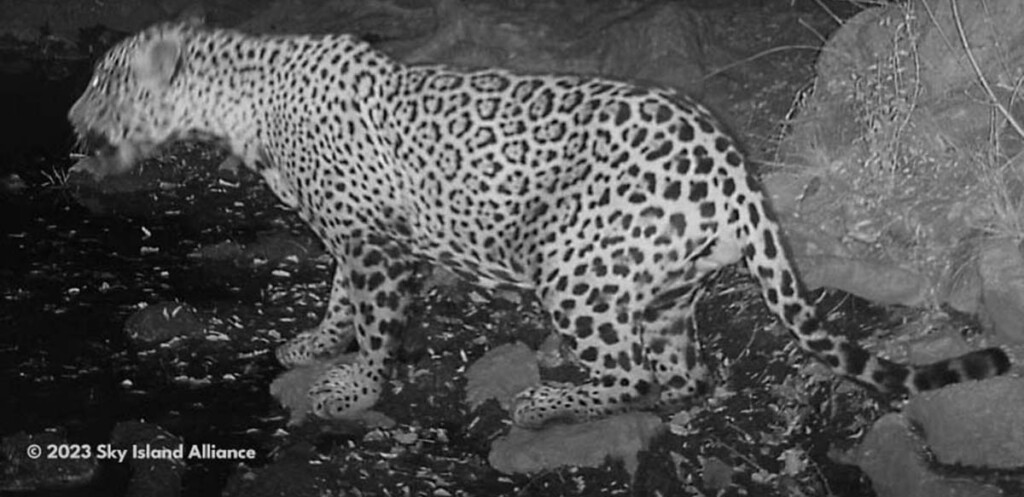
To promote wildlife resilience and land integrity in the face of relentless development and habitat fragmentation, Sky Island Alliance focuses our work within what we call the Path of the Jaguar. This represents both the literal and symbolic journey of the iconic endangered jaguar, which makes its home in our region. Our 30 years of conservation experience and research have shown that by protecting the connected open space that jaguars need to thrive, we’re actually benefiting hundreds of other species. That includes the other wild cats that live here — ocelots, bobcats, and mountain lions.
A little background for those who are unfamiliar: The Sky Island borderlands are home to an incredibly diverse range of species, including the northernmost jaguars in the world. Although Arizona once hosted a healthy breeding population, these majestic cats were systematically exterminated in the U.S. Southwest in the 20th century. Now protected by law, jaguars are making a comeback in Arizona. And in the past few years, they’ve been photographed in multiple Sky Islands in the state, inspiring hope that breeding jaguars are closer to the border than previously thought. These individuals are part of a core population just across the border in Sonora, Mexico. The hope is that jaguars will return to Arizona if we protect the habitat and pathways they need to survive.
The catch is that this crucial corridor, the Path of the Jaguar, is under continued threat.
Indeed, the Sky Islands are still ground zero for one of the largest landscape-fragmentation events in human history: construction of a 30-foot-tall steel wall at the U.S.-Mexico border. Until the Biden administration paused border wall construction in January 2021, we witnessed the acceleration of activities that destroyed habitat and severed vital wildlife corridors, including 93% of jaguars’ designated critical habitat along the Arizona border. The damage that occurred in 2020 is severe, with two-thirds of the U.S.-Mexico border in Arizona now blocked by wall and impassable for jaguars and other migrating species. The best hope we have to save these vulnerable cats is to prevent further destruction at the border, ensure safe passage for wildlife through small gaps in the wall, and recover key habitat features on either side of the border until landscape-level restoration occurs.
Meanwhile, just south of the border in Sonora today, jaguars, ocelots, mountain lions, and bobcats roam the mountain forests and grasslands of the Bavispe Wildlife Protection Area and Northern Jaguar Reserve. Wild cats thrive here because of the reserves’ remoteness from urban life and due to the rich variety of habitats blanketing the Sky Island slopes. When these cats move, however, as they do, they must run a gauntlet through private cattle ranchlands to cross between Bavispe’s five management units and to reach protected areas in Arizona after crossing through gaps in the border wall. The National Commission of Natural Protected Areas of Mexico (CONANP) is doing excellent work in the area but has suffered budget cuts that have reduced its capacity to do conservation work in and around the reserve. And while Bavispe is federally protected (and the only such area in the Mexican Sky Islands), it doesn’t yet have a conservation and management program, which will help take efforts to the next level.
The way forward then is simple but also incredibly complex: To protect the Path of the Jaguar, we must provide safe passage between protected areas in Sonora and the U.S.
To that end, we’ve identified the wildlife pathways that allow jaguars and other species to move north-south and between Sky Islands. In Sonora, we’re working with several ranches on restoration projects to help their lands thrive and be additional safe spaces for wildlife as they move. We’re also working with CONANP and Bavispe land managers about next steps in enhancing habitat and engaging the community. In Arizona, we’re focusing on rewilding old roads in the Coronado National Forest to restore border-adjacent lands. And we’re rescuing springs that provide important sources of water for jaguars on the move. By thus supporting recovery of jaguars as a top predator, which we know are very sensitive to habitat disturbance, we aspire to sustain the health of the entire region.
If you’d like to learn more about jaguars and what’s next for the species in the borderlands, please join us for our next virtual Coffee Break on Feb. 29 at 9:30 a.m., featuring U.S. Fish and Wildlife Service jaguar expert Marit Alanen. And stay tuned for more updates on our work — and hopefully many more big cats.

